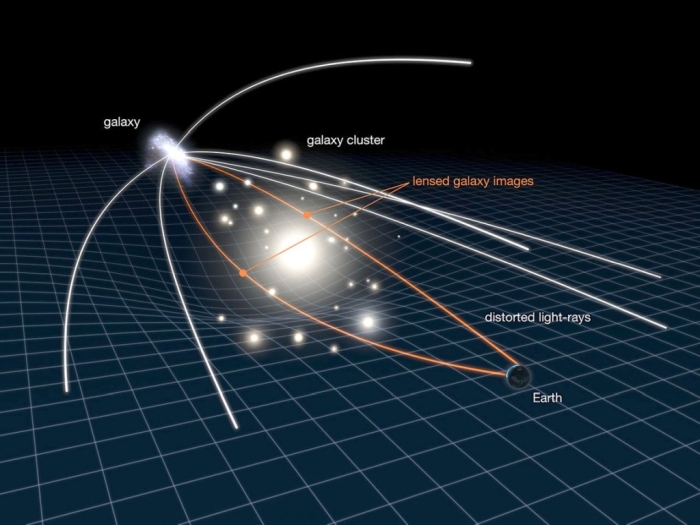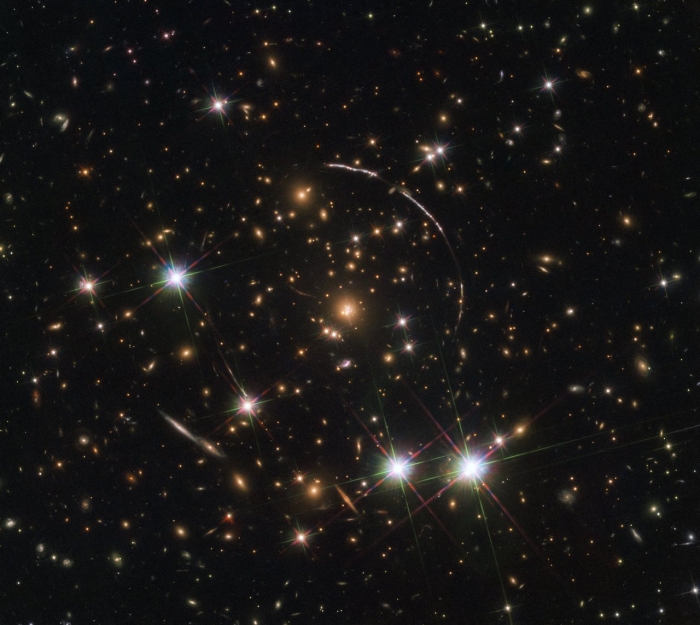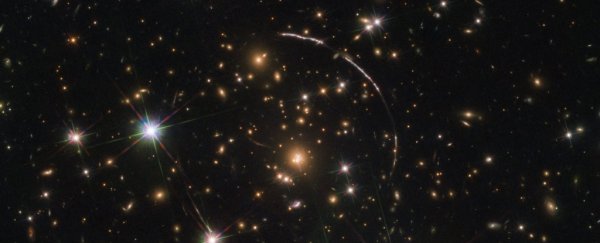The smears of light you can see arcing across a new Hubble photo aren't strange artefacts or smudges on the space telescope's lens. Rather, they're the light of a galaxy 11 billion light-years away, distorted and replicated by gravity in the foreground.
At least 12 copies of the galaxy - called PSZ1 G311.65-18.48 and nicknamed the Sunburst Arc - streak across the sky. Thanks to this phenomenon, astronomers can study it in incredible detail.
Gravity, as we all know, is very attractive. It's the invisible and mysterious force that binds the Universe, proportional to mass. The more mass an object has, the stronger its gravity. And it's not just physical matter it attracts; a powerful gravity well can also divert the path of light.
On galactic scales, this means that something with a lot of gravity - such as a cluster of galaxies, for example - can bend and magnify the light of something behind it in the far distance.
This is called gravitational lensing, an effect predicted by Einstein. Astronomers regularly use it to study galaxies in the early Universe that would otherwise be too faint to see well.
 (ESA/NASA)
(ESA/NASA)
And this lensing effect can even duplicate images, making multiple copies of a faint, distant galaxy. That's what we're seeing with the Sunburst Arc, although with many more copies than is usual.
Between us and the galaxy, at a distance of 4.6 billion light-years, is a massive cluster of galaxies that's bending and splitting the Sunburst Arc's light. At least 12 copies of the galaxy appear in Hubble's photo, split over four major arcs - three in the top right and one in the bottom left of the photo.
Because of the strength of the lensing, the Sunburst Arc is one of the brightest known lensed galaxies, even at its great distance. Some of the copies of the galaxy are 10 to 30 times brighter than the actual galaxy itself - which allows astronomers to make out features as small as 520 light-years across.
 (ESA/Hubble, NASA, Rivera-Thorsen et al.)
(ESA/Hubble, NASA, Rivera-Thorsen et al.)
That seems pretty big to us, but some star-forming regions and nebulae can easily spread across that much space. These structures can then be compared to those in much younger galaxies, to learn how galaxies have changed over time.
The Hubble images also show that the Sunburst Arc is analogous to the very first galaxies in the Universe, around the time of the Epoch of Reionisation, which took place around 13.3 to 12.8 billion years ago.
Some 300,000 years after the Big Bang, the Universe was completely opaque, filled with neutral hydrogen. Then, something came along and ionised the hydrogen, making the Universe transparent again.
It's very hard to see things from that time, so it's proving tricky to figure out the exact mechanisms that took place during the Epoch.
Astronomers think it was radiation from the first stars and galaxies that worked this magic, but there's a problem: the high-energy radiation required to ionise the hydrogen needed to have been able to escape galaxies without being absorbed by the interstellar medium. Only a small number of galaxies have been found to do this.
The Sunburst Arc contains a clue, however. It shows that some photons can "leak" through narrow channels in neutral medium that has a lot of gas.
The more we learn about the Epoch of Reionisation, the more it seems there had to have been a number of contributing factors. The way photons leak from the Sunburst Arc is unlikely to have been solely responsible, but it could have been a pretty important contributor.
All that from some smudged galactic light in the sky!
The research has been published in Science.
